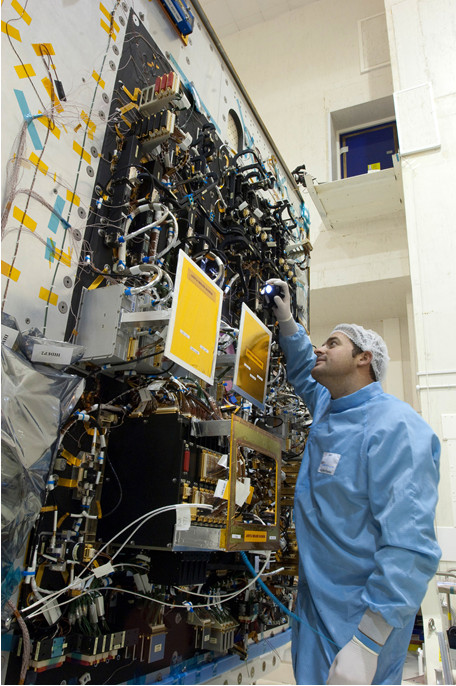The data bus is one of most critical parts of a control & data handling system. This is no less the case with satellites. On modern spacecraft, it serves as the central interface between spacecraft controller and the individual peripherals and payloads.
The Controller Area Network bus, or CAN bus, is a standard which has been widely used in the automotive and other industries since chipsets that support it first came on the market in 1987.
In 2006, the ARTES programme started funding development of a new data bus for spacecraft, based on the CAN bus, that would be compatible with the next generation of more versatile and powerful telecom payloads.
Previously there was no common standard data bus interface that specifically addressed all the requirements of the space industry. CAN bus was chosen because it offered numerous advantages: it is robust, low-cost, has low power-consumption, numerous development tools are available for it, and it has a large user base in Europe.
As the satcoms industry has matured, it has become increasingly more price-sensitive, and lowering the costs of such basic key components as the data bus through open standardisation was seen as essential for Europe’s satellite builders to remain competitive.
long-term strategy
ESA’s goal was three-fold:
First, to define a CAN bus implementation compatible with satcom environments and requirements.
Second, to ensure rapid time-to-market by propagating the open standard through the industry.
Third, to validate the new CAN implementation to foster its use for commercial satcoms missions.
Through the Competitive & Growth element of the ARTES programme, a series of activities were undertaken by two of Europe’s leading satellite prime contractors, Airbus Defence and Space, and Thales Alenia Space, which encompassed developing and qualifying CAN Bus for Space. As part of an ARTES 5.2 activity undertaken by Airbus DS, TESAT Spacecom delivered a technology demonstration unit with the CAN bus interface to support a CAN bus system test with flight-representative hardware.
The process took a decade, but CAN Bus for Space is now flight-ready. The first flight opportunities for CAN Bus for Space will be on two spacecraft being built by Airbus DS based on the Eurostar 3000 platform (one with standard chemical propulsion and one with electrical orbit raising). It has also been adopted by both Airbus DS and TAS, for respectively Eurostar Neo and Spacebus Neo, the ESA programme to develop and qualify two new satellite product lines that will enable the European space industry to deliver commercially competitive satellites in the 3 to 6 tons launch mass range. It will be implemented for the first Spacebus Neo mission slated for 2019.
towards an industry standard
“CAN Bus for telecom payloads is assumed to be the enabling factor for equipment standardization and implementation of new functionalities while moving towards a minimum harness. Going towards this standard will finally help to focus development effort on equipment key features rather than on interface adaptations,” says Jens Freese, HO RF Amplifier Development at TESAT Spacecom.
“Beyond the improved data bus performance and harness reduction, we expect that CAN Bus for Space will reduce time to market and insure interoperability,” says Jean Dalenq, MSC Expert at Airbus Defence and Space. “During this development, all players (agencies, primes, equipment suppliers and components manufacturers) have pushed in the same direction. This was clearly a significant part of the success.”
“CAN Bus for Space has been adopted by all the major European satellite manufacturers,” says King Lam, ESA Spacecraft Engineer in the Telecom directorate’s Platform section. “It is baselined to be used for all their future commercial telecoms platforms and payloads. Eventually it should become a global standard, as satellite manufacturers in the United States move to adopt it as well.”
“CAN Bus for Space is a true ESA success story,” says ESA’s Gianluca Furano, On-Board Computer Engineer in the TEC directorate who was closely involved in the decade-long development. “Achieving standardisation is an immensely complex challenge, requiring detailed engineering coordination among many different players, something that could only be achieved under the aegis of an organisation like ESA, with the long-term support of the ARTES programme.”
“As the aerospace industry adopts the new data bus, the multiplier effect of the ARTES investment should be enormous,” he says.
upcoming event
First CAN in Space Conference, 14–16 Jun 2017, Mola di Bari (Puglia), Italy. For more information, see the conference website.




